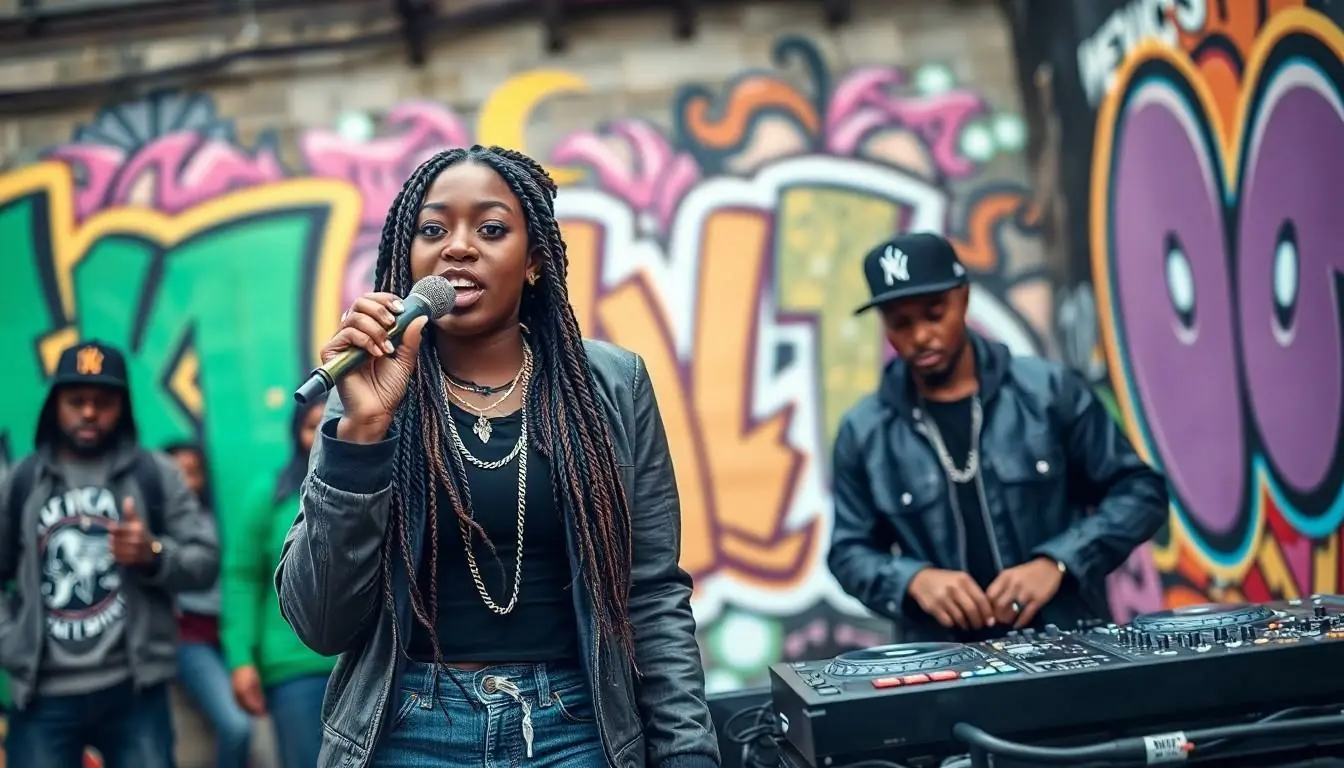Rap and hip hop—two terms often tossed around like confetti at a block party. But do they mean the same thing? If you think they’re interchangeable, you might be in for a surprise. While they share a vibrant cultural heritage, they each have their own unique flair that sets them apart.
Imagine rap as the spicy salsa at a party—bold, energetic, and ready to make you move. Hip hop, on the other hand, is the entire fiesta, encompassing not just the music but the dance, fashion, and art that come along for the ride. So, before you mix them up like a DJ at a wedding, let’s dive into the rhythm and explore how these two powerhouses of culture differ and why it matters.
Table of Contents
ToggleUnderstanding Rap and Hip Hop
Rap and hip hop embody distinct elements within a broader cultural narrative. Understanding their differences enriches one’s appreciation for both forms.
Historical Origins
Origins of rap trace back to African American communities in the late 1970s. DJs and MCs in the Bronx, New York, played a crucial role in its development. Rhythmic spoken word coupled with beats characterized early rap performances. Hip hop, on the other hand, encompasses a cultural movement that emerged around the same time, incorporating music, dance, visual art, and fashion. Events like block parties fostered a sense of community while sparking the growth of both art forms. By the 1980s, both surged in popularity, leading to the establishment of lasting influence.
Cultural Context
Cultural context shapes the identities of rap and hip hop. Rap primarily focuses on lyrical expression through rhythm and rhyme. Themes often include social issues, personal struggles, and identity. In contrast, hip hop represents a lifestyle and cultural movement that extends beyond music. Elements like breakdancing and graffiti art contribute to this definition. Each art form interacts with communities through various mediums, influencing fashion, language, and attitudes. Both cultivate vibrant scenes, serving as platforms for expression and social commentary.
Musical Elements

Rap and hip hop comprise distinct musical components that contribute to their unique identities. Understanding these elements highlights the differences between the two.
Rhythm and Beats
Rhythm serves as the backbone of rap, relying heavily on intricate beats. DJs employ sampling techniques to create lively music that motivates listeners. The structure often features a strong emphasis on bass and percussion. Beats will vary significantly, ranging from old school styles to contemporary trap. Hip hop utilizes rhythms, too, but incorporates a wider variety of musical influences, such as jazz and funk. Styles adapt over time, showcasing the genre’s evolution. Both genres create engaging soundscapes, yet rap maintains a stronger focus on beat-driven aspects.
Lyrics and Flow
Lyrics form the core of rap, emphasizing storytelling and personal experiences. The flow defines how the words fit within the rhythm, showcasing the artist’s skill. Artists like Nas and Kendrick Lamar use complex rhyme schemes and metaphors to evoke emotions and provoke thought. In contrast, hip hop lyrics may focus more on the cultural experience, blending messages about community and identity. While both genres prioritize lyrical expression, rap hones in on individual narratives. Hip hop often embraces collective storytelling and shared experiences, resulting in broader themes.
Distinctions Between Rap and Hip Hop
Rap and hip hop, while closely related, differ significantly in their essence. Understanding these distinctions enhances appreciation for both forms.
Artistic Expression
Rap emphasizes lyrical storytelling, allowing artists to convey personal experiences and social issues through intricate wordplay. Its focus centers on rhythm and rhyme, engaging listeners with powerful narratives. Many rappers tackle themes like identity, struggle, and resilience, reflecting their backgrounds and community challenges. In contrast, hip hop embodies a broader cultural movement, encompassing dance, visual art, and fashion. This eclectic creativity fosters artistic expression beyond music, showcasing diverse talents such as graffiti and breakdancing in addition to rap. Each element contributes uniquely to the overall hip hop culture, creating a rich tapestry of artistic diversity.
Genre Classification
Rap sits within the hip hop genre but stands alone as a distinct musical style. Rap primarily focuses on vocal delivery and rhythmic patterns, utilizing beats crafted through sampling and production techniques. Its structure often adheres to specific flow patterns that amplify lyrical content. Hip hop, however, represents an all-encompassing genre that includes various artistic disciplines, from DJing to b-boying. While rap centers on songwriting and performance, hip hop encompasses the lifestyle and cultural practices associated with these art forms. Recognizing this classification clarifies their roles within the music industry and cultural communities.
Influence on Society
Rap and hip hop significantly shape societal perspectives and behaviors. They serve as powerful tools for communication, reflection, and change.
Social Commentary
Rap frequently provides critiques of societal issues, addressing themes like poverty, racism, and inequality. Artists often share personal experiences and insights that resonate with listeners facing similar struggles. Lyrics act as a voice for marginalized communities, highlighting injustices and advocating for change. Hip hop culture complements this by offering an outlet for visual arts and dance, marrying various forms of artistic expression. This multifaceted approach creates a platform where pressing social topics gain visibility.
Impact on Youth Culture
Youth culture reflects strong influences from rap and hip hop, impacting fashion, language, and values. Many young people adopt styles inspired by their favorite artists, from clothing brands to hairstyles. The music serves as a backdrop to social interactions, shaping the vocabulary of younger generations. Events like concerts and block parties foster community bonding, and these genres encourage self-expression and creativity. Through these cultural avenues, both rap and hip hop cultivate a sense of identity among youth.
Understanding the distinction between rap and hip hop enriches appreciation for both forms. Rap serves as a powerful medium for personal storytelling and social critique, while hip hop represents a vibrant cultural movement that encompasses various artistic expressions. Each plays a vital role in shaping communities and influencing youth culture. Recognizing their unique characteristics allows individuals to engage more deeply with the music and the messages behind it. This awareness fosters a greater respect for the artistry and impact of both rap and hip hop in today’s society.


